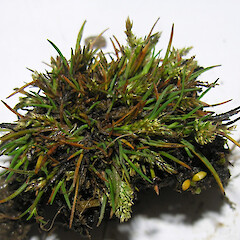Agrostis muelleriana
Synonyms
Agrostis canina var. beta Hook.f.; A. gelida F.Muell., A. canina var. beta gelida (F.Muell.) Buchanan, A. muelleri Benth.
Family
Poaceae
Flora category
Vascular – Native
Endemic taxon
Yes
Endemic genus
No
Endemic family
No
Structural class
Grasses
NVS code
The National Vegetation Survey (NVS) Databank is a physical archive and electronic databank containing records of over 94,000 vegetation survey plots - including data from over 19,000 permanent plots. NVS maintains a standard set of species code abbreviations that correspond to standard scientific plant names from the Ngä Tipu o Aotearoa - New Zealand Plants database.
AGRMUE
Chromosome number
2n = 42
Current conservation status
The conservation status of all known New Zealand vascular plant taxa at the rank of species and below were reassessed in 2017 using the New Zealand Threat Classification System (NZTCS) – more information about this can be found on the NZTCS website. This report includes a statistical summary and brief notes on changes since 2012 and replaces all previous NZTCS lists for vascular plants.
Please note, threat classifications are often suggested by authors when publications fall between NZTCS assessment periods – an interim threat classification status has not been assessed by the NZTCS panel.
- Conservation status of New Zealand indigenous vascular plants, 2017 . 2018. Peter J. de Lange, Jeremy R. Rolfe, John W. Barkla, Shannel P. Courtney, Paul D. Champion, Leon R. Perrie, Sarah M. Beadel, Kerry A. Ford, Ilse Breitwieser, Ines Schönberger, Rowan Hindmarsh-Walls, Peter B. Heenan and Kate Ladley. Department of Conservation. Source: NZTCS and licensed by DOC for reuse under the Creative Commons Attribution 4.0 International licence.
2017 | Not Threatened | Qualifiers: SO
Previous conservation statuses
2012 | Not Threatened
2009 | Not Threatened
2004 | Not Threatened
Distribution
Indigenous. North Island, uncommon, central mountains only. South Island, throughout the mountains. Indigenous to Australia (New South Wales, Victoria and Tasmania)
Habitat
Montane to alpine in scree, rocky ground, fell field and in seepages
Manaaki Whenua Online Interactive Key
Similar taxa
Agrostis subulata Hook.f. which is confined to the Antipodes and Campbell Islands and has light green or occasionally purple-tinged, minutely pubescent-scabrid glumes.
Life cycle
Florets are dispersed by wind and water (Thorsen et al., 2009).
Propagation technique
Easy from fresh seed. Grows very well in small pots and within a rockery but requires a shaded spot at low altitudes and dislikes humidity. Will not flower unless subjected to cold treatment.
Etymology
agrostis: Greek name for a kind of grass
muelleriana: Named after Baron Ferdinand von Mueller, 19th century German/Australian botanist and founder of the National Herbarium of Victoria
Where To Buy
Not commercially available
References and further reading
Thorsen MJ, Dickinson KJM, Seddon PJ. 2009. Seed dispersal systems in the New Zealand flora. Perspectives in Plant Ecology, Evolution and Systematics 11: 285–309.









